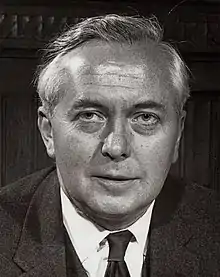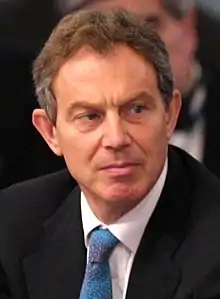| Leader of the Labour Party | |
|---|---|
| Status | Party leader |
| Member of | National Executive Committee |
| Precursor | Chair of the PLP |
| Inaugural holder | Keir Hardie |
| Formation | 17 January 1906 |
| Deputy | Deputy Leader of the Labour Party |
The leader of the Labour Party is the highest position within the United Kingdom's Labour Party. The current holder of the position is Keir Starmer, who was elected to the position on 4 April 2020, following his victory in the party's leadership election.
The post of Leader of the Labour Party was officially created in 1922. Before this, between when Labour MPs were first elected in 1906 and the general election in 1922, when substantial gains were made, the post was known as Chairman of the Parliamentary Labour Party.[1] In 1970, the positions of leader of the Labour Party and chairman of the Parliamentary Labour Party were separated.
In 1921, John R. Clynes became the first leader of the Labour Party to have been born in England; all party leaders before him had been born in Scotland. In 1924, Ramsay MacDonald became the first ever Labour prime minister, leading a minority government which lasted nine months. Clement Attlee would become the first Labour leader to lead a majority government in 1945. The first to be born in Wales was Neil Kinnock, who was elected in 1983. The most electorally successful leaders of the Labour Party to date are Tony Blair, who won three consecutive electoral victories in 1997, 2001 (both landslide victories), and 2005, and Harold Wilson, who won four general elections out of five contested, in 1964, 1966, February 1974 and October 1974. As of 2021, the only Labour leaders not to contest a general election (excluding temporary acting leaders) are George Lansbury (who stood down), John Smith (who died in office), and Keir Starmer.[lower-alpha 1]
When the Labour Party is in opposition, as it currently is, the leader of the Labour Party usually acts (as the second largest party) as the leader of the Opposition, and chairs the shadow cabinet. Concordantly, when the Party is in government, the leader would usually become the prime minister of the United Kingdom, first lord of the Treasury and minister for the civil service, as well as appointing the cabinet.
Selection process
Unlike other British political party leaders, the Labour leader does not have the power to dismiss or appoint their deputy. Both the leader and deputy leader are elected by an alternative vote system.
From 1980 to 2014 an electoral college was used, with a third of the votes allocated to the Party's MPs and MEPs, a third to individual members of the Labour Party, and a third to individual members of all affiliated organisations, including socialist societies and trade unions.
The 2015 leadership election used a "one member, one vote" system, in which the votes of party members and members of affiliated organisations are counted equally. MPs' and MEPs' votes are not counted separately, although a candidate needs to receive the support of 10% of Labour MPs in order to appear on the ballot.[2]
Leaders of the Labour Party (1906–present)
- Note: the right-hand column does not allocate height proportional to time in office.
A list of leaders (including acting leaders) since 1906.[3]
| No. | Leader (birth–death) |
Constituency | Took office | Left office | Prime Minister (term) | ||
|---|---|---|---|---|---|---|---|
| 1 | Keir Hardie (1856–1915) |
 |
Merthyr Tydfil | 17 February 1906 | 22 January 1908 | Campbell-Bannerman 1905–1908 | |
| 2 | Arthur Henderson (1863–1935) (1st time) |
 |
Barnard Castle | 22 January 1908 | 14 February 1910 | ||
| Asquith 1908–1916 | |||||||
| 3 | George Barnes (1859–1940) |
 |
Glasgow Blackfriars and Hutchesontown | 14 February 1910 | 6 February 1911 | ||
| 4 | Ramsay MacDonald (1866–1937) (1st time) |
 |
Leicester | 6 February 1911 | 5 August 1914 | ||
| (2) | Arthur Henderson (1863–1935) (2nd time) |
 |
Barnard Castle | 5 August 1914 | 24 October 1917 | ||
| Lloyd George 1916–1922 | |||||||
| 5 | William Adamson (1863–1936) |
 |
West Fife | 24 October 1917 | 14 February 1921 | ||
| 6 | J. R. Clynes (1869–1949) |
.jpg.webp) |
Manchester Platting | 14 February 1921 | 21 November 1922 | ||
| Law 1922–1923 | |||||||
| (4) | Ramsay MacDonald (1866–1937) (2nd time) |
.jpg.webp) |
Aberavon | 21 November 1922 (elected) |
28 August 1931 | ||
| Baldwin 1923–1924 | |||||||
| Himself 1924 | |||||||
| Baldwin 1924–1929 | |||||||
| Himself 1929–1931 | |||||||
| (2) | Arthur Henderson (1863–1935) (3rd time) |
 |
Burnley (1931) None[lower-alpha 2] (1931–1932) |
28 August 1931 (unopposed) |
25 October 1932 | MacDonald 1931–1935 | |
| 7 | George Lansbury (1859–1940) |
 |
Bow and Bromley | 25 October 1932 (unopposed) |
8 October 1935 | ||
| Baldwin 1935–1937 | |||||||
| 8 | Clement Attlee (1883–1967) |
 |
Limehouse (1935–1950) Walthamstow West (1950–1955) |
8 October 1935 (elected) |
7 December 1955[4] | ||
| Chamberlain 1937–1940 | |||||||
| Churchill 1940–1945 | |||||||
| Himself 1945–1951 | |||||||
| Churchill 1951–1955 | |||||||
| Eden 1955–1957 | |||||||
| ― | Herbert Morrison[lower-alpha 3] (1888–1965) |
 |
Lewisham South | 7 December 1955 | 14 December 1955 | ||
| 9 | Hugh Gaitskell (1906–1963) |
 |
Leeds South | 14 December 1955 (elected) |
18 January 1963 (died in office) |
||
| Macmillan 1957–1963 | |||||||
| ― | George Brown[lower-alpha 3] (1914–1985) |
 |
Belper | 18 January 1963 | 14 February 1963 | ||
| 10 | Harold Wilson (1916–1995) |
 |
Huyton | 14 February 1963 (elected) |
5 April 1976 | ||
| Douglas-Home 1963–1964 | |||||||
| Himself 1964–1970 | |||||||
| Heath 1970–1974 | |||||||
| Himself 1974–1976 | |||||||
| 11 | James Callaghan (1912–2005) |
.jpg.webp) |
Cardiff South East | 5 April 1976 (elected) |
10 November 1980 | Himself 1976–1979 | |
| Thatcher 1979–1990 | |||||||
| 12 | Michael Foot (1913–2010) |
.jpg.webp) |
Ebbw Vale | 10 November 1980 (elected) |
2 October 1983 | ||
| 13 | Neil Kinnock (b. 1942) |
.jpg.webp) |
Islwyn | 2 October 1983 (elected) |
18 July 1992 | ||
| Major 1990–1997 | |||||||
| 14 | John Smith (1938–1994) |
Monklands East | 18 July 1992 (elected) |
12 May 1994 (died in office) |
|||
| ― | Margaret Beckett[lower-alpha 3] (b. 1943) (acting) |
 |
Derby South | 12 May 1994 | 21 July 1994 | ||
| 15 | Tony Blair (b. 1953) |
 |
Sedgefield | 21 July 1994 (elected) |
24 June 2007 | ||
| Himself 1997–2007 | |||||||
| 16 | Gordon Brown (b. 1951) |
.jpg.webp) |
Kirkcaldy and Cowdenbeath | 24 June 2007 (unopposed) |
11 May 2010 | Himself 2007–2010 | |
| ― | Harriet Harman[lower-alpha 3] (b. 1950) (acting: 1st time) |
 |
Camberwell and Peckham | 11 May 2010 | 25 September 2010 | Cameron 2010–2016 | |
| 17 | Ed Miliband (b. 1969) |
 |
Doncaster North | 25 September 2010 (elected) |
8 May 2015 | ||
| ― | Harriet Harman[lower-alpha 3] (b. 1950) (acting: 2nd time) |
 |
Camberwell and Peckham | 8 May 2015 | 12 September 2015 | ||
| 18 | Jeremy Corbyn (b. 1949) |
 |
Islington North | 12 September 2015 (elected) |
4 April 2020 | ||
| May 2016–2019 | |||||||
| Johnson 2019–2022 | |||||||
| 19 | Sir Keir Starmer (b. 1962) |
 |
Holborn and St Pancras | 4 April 2020 (elected) |
Incumbent | ||
| Truss 2022 | |||||||
| Sunak 2022 – present | |||||||
Timeline

Leaders in the House of Lords
Retirement
It is not uncommon for a retired leader of the Labour Party to be granted a peerage upon their retirement, particularly if they served as prime minister; examples of this include Clement Attlee and Harold Wilson. However, Neil Kinnock was also elevated to the House of Lords, despite never being prime minister, and Michael Foot declined a similar offer.
See also
Notes
- ↑ See Labour's electoral performance.
- ↑ Henderson was defeated in his Burnley seat in the 1931 election, and did not return to Parliament during his third term as leader. George Lansbury acted as the Labour parliamentary leader, until formally succeeding Henderson as party leader.
- 1 2 3 4 5 Deputy Leaders who assumed the role of party leader temporarily because of the death or resignation of the incumbent, serving until the election of a new leader. As they were not elected or appointed in an official capacity, they are not included in the order count. Herbert Morrison acted as leader for the seven days between Clement Attlee's resignation and Hugh Gaitskell's election as leader. George Brown and Margaret Beckett acted as leader following deaths of Gaitskell and John Smith, respectively. Harriet Harman acted as leader twice when Gordon Brown and Ed Miliband resigned.
References
- ↑ Thorpe, Andrew. (2001) A History of the British Labour Party, Palgrave, ISBN 0-333-92908-X
- ↑ "Labour proposals 'all-but guarantee leftwing Corbyn successor'". www.msn.com. Retrieved 2018-07-01.
- ↑ Boothroyd, David. "Leaders of the Labour Party". election.demon.co.uk. United Kingdom Election Results. Archived from the original on 6 August 2020. Retrieved 30 June 2015.
- ↑ Nicklaus Thomas-Symonds (2010), Attlee: A Life in Politics, London: I B Tauris, p. 260
Further reading
- Clarke, Charles; James, Toby S. (2015). British Labour Leaders. London: Biteback.
